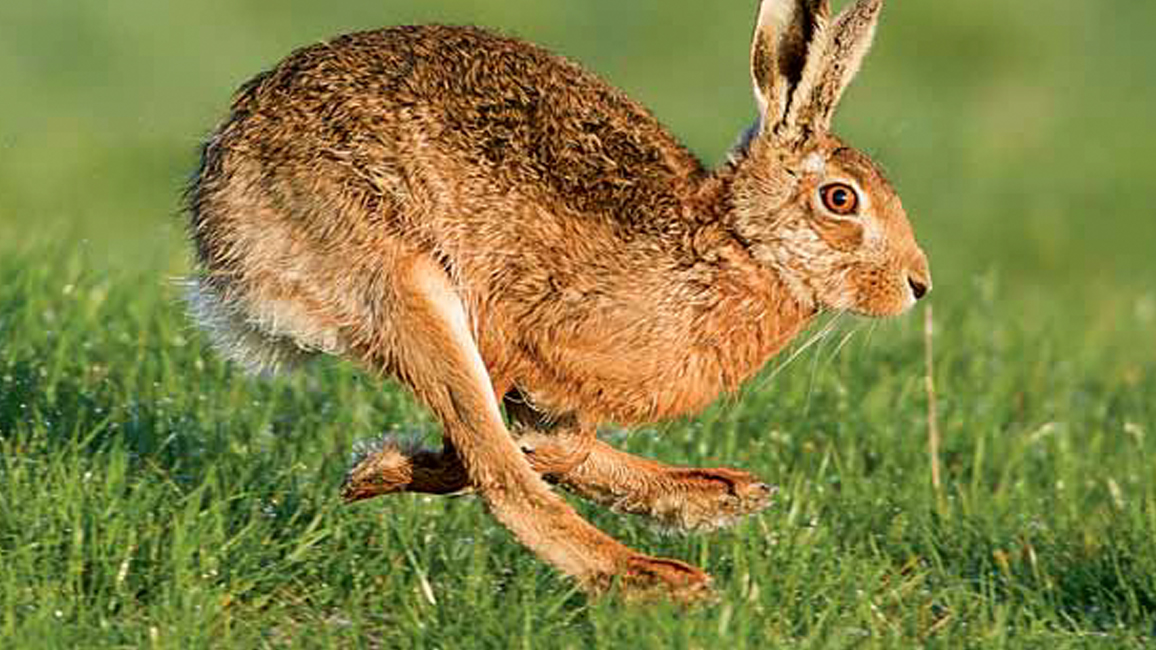
Hares
By Becky Hare, as told to Kathy KrankingIf you think hares are the same as rabbits you’re “jumping” to the wrong conclusion. Hares and rabbits are related, but hares are not rabbits. Hares are hares!
Though we hares may look like rabbits at first glance, there are some pretty big differences between us. For one thing, hares are larger than rabbits. We also have longer ears and hind legs. And, while most rabbits live in burrows, we hares just hunker down in low areas in the grass called forms (See circle above left.) Finally, baby rabbits are born with their eyes closed and no hair. Newborn hares are just the opposite—eyes open, fully furred, and ready to go!
BUILT FOR BOUNDING
I hate to brag, but we hares are very talented. For one thing, we’re lean, mean leaping machines! Our long legs and big feet help us make leaps up to 10 feet long.
We’re speedy runners, too. Some kinds of hares can zip along at 35 miles per hour. When an enemy is after us, we get speedy and tricky, running in zigzag patterns or even backtracking. That makes us a lot harder to catch.
PERFECT PARTS
Hares are talented in other ways, too. Take our most famous body parts: our big ears. We have great hearing. And we’re even able to swivel our ears around to listen in different directions at the same time. Don’t you wish you could do that?
Besides having awesome ears, we also have a strong sense of smell and good eyesight. Our eyes are on the sides of our heads, so we can see what’s in front of us, above us, to the sides, and partly behind us—all at the same time. We also see well in the dark. And our sensitive noses can even sniff out food that’s underneath snow and ice. Together, our eyes, ears, and noses make a great early-warning system. And that’s what we need for escaping foxes, hawks, and other predators.
ON THE MENU
Here’s another thing we hares are good at: eating! We always eat our veggies. Grasses and other plants are our favorites. But we’ll also eat things such as buds, bark, seed, and berries. Our teeth are built for what we eat. In the front of a hare’s mouth are sharp teeth for ripping off plant stems. Behind those are bigger, flat teeth for grinding up food.
Something else we hares have in our diet might gross you out: We eat some of our own droppings! See, our food gets only partly digested when it goes through us. So by eating the droppings, we get nutrients we missed the first time. Dining on droppings might sound hare-brained to you, but it works for us!
MARCH HARES
When mating season comes, things really get hopping for us hares. That’s when the males start looking for mates. When a male finds a female he hopes to mate with, he chases after her. But if she’s not ready to mate just yet, she may take off at top speed. Or she may stand her ground and punch the male with her front feet! After a while, she will stop “boxing” and allow the male to be her mate.
People have an expression, “mad as a March hare,” that describes us hares during the mating season. With all the chasing and boxing that goes on, I guess we do look as if we’ve gone a little crazy!
SECRET BABIES
After mating is over, things calm down. The male hares go their separate ways, and we females raise the babies ourselves.
Baby hares usually “lie low” in their forms, hidden (we hope) from enemies. A mother hare leaves her babies alone for most of the day. She comes back to nurse them for only five minutes each evening! She’s not being stingy. It’s for the babies’ own safety. By visiting only once a day, the mom draws less attention to the babies than if she were coming and going all the time. And that can help protect them from hungry enemies.
After about a month, the baby hares are ready to be on their own. And then it’s time for them to hippety-hop away into their new lives.
“Hooray for Hares” originally appeared in the April 2013 issue of Ranger Rick magazine.
(Click on each image above for a closer view of the story.)



















